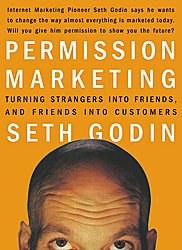Everything on Facebook is an ad


The theory goes like this.
You give people new ways of getting into your site's services and they are not going to be looking at your ads. No ads, no money, no business.
But there is a deeper question at work, namely the future of the advertising model, and how open source might hasten its replacement.
Ads, in general, are a shrinking water hole, both because the economy is contracting and because their usefulness is declining. Many sites built with open source software depend on advertising revenue, the thinking goes, so we're cutting off our noses to spite our faces.
I think something deeper is going on and can be summarized this way.
Everything on Facebook is an ad.
Facebook, like all its rivals, is about relationships. Their mission is to bring people together, casually, as friends, even intimately. That's what advertisers do, too.
In his 1999 classic Permission Marketing, Seth Godin described all the levels of permission most marketers care about.
This starts with transaction permission, which happens when you buy a hamburger, and extends to intravenous permission, as when the doctor assumes you'll pay for the blood that saves your life after an accident.
This is like assuming that relationships start with a one-night stand and extend to your son giving you his kidney. There's a bit more to life than that.
What Godin does not do is describe the various levels of permission that occur before the transaction happens. There are several, as anyone who has been on a date will tell you:
- Stranger permission, as when you first see someone or look at an ad.
- Pitch permission, as when you let someone ask you for coffee or listen to a salesman.
- Relationship permission, as when you acknowledge someone or talk about some great ad you've seen.
- Friendship permission, as when you go for a second cup of coffee with someone or identify yourself with a product or service.
At no time here does a transaction occur. At no time does money change hands. But each step of this journey may be essential toward someone actually making a purchase and (more important) giving you deeper levels of permission.
Don't think sex. Think seduction.
All social networks, all Internet connections, create these shallow types of relationships. They're the editorial "meat" in the meet-up, as it were.
Companies have a hard time with all this. They see the costs and not the benefits. Yet the Internet makes it cheap-and-easy to build these kinds of non-transaction relationships with people, relationships that will make your product or service the only choice when the customer's need arises.
What nearly all companies do is act like a bad date, the guy or girl who is trying too hard, who is trying to be perfect. You know the type. You have failed to return their calls often enough.
Social networks can help companies build these shallower levels of permission, if clients are willing to do what's necessary to build them. That's the opportunity social networks, regardless of their source code, offer marketers.
The next great marketing genius will figure out how to make that equation work.